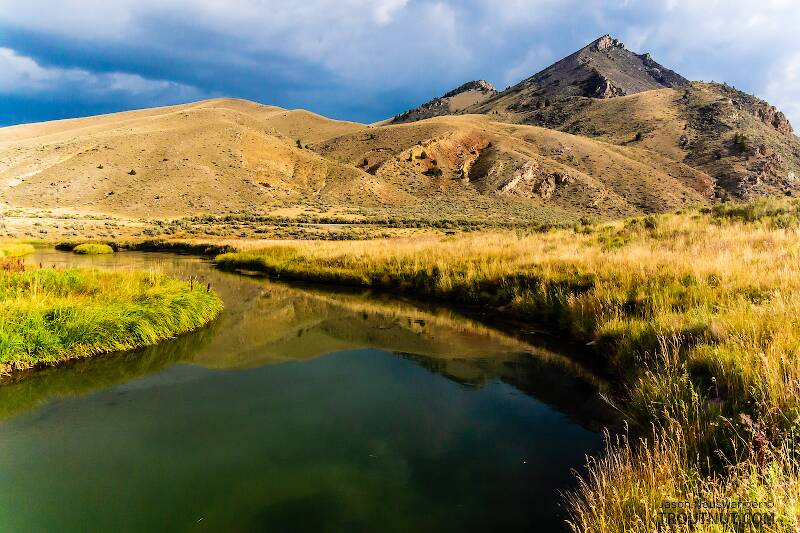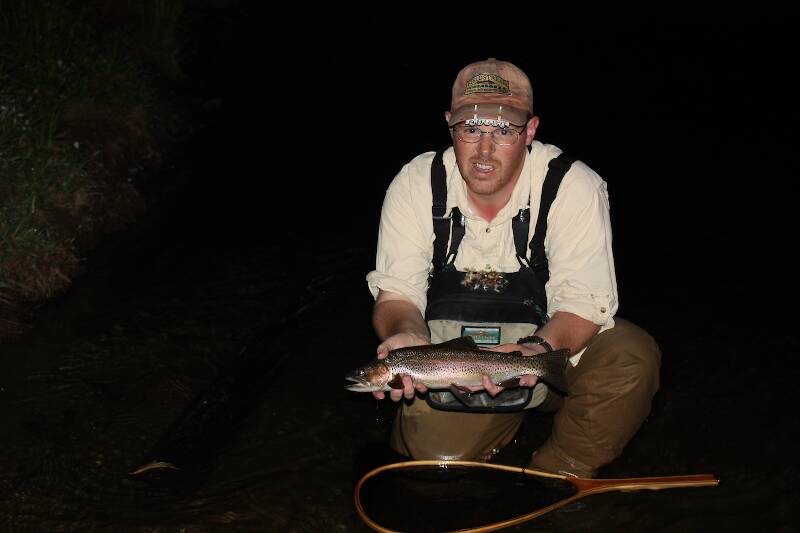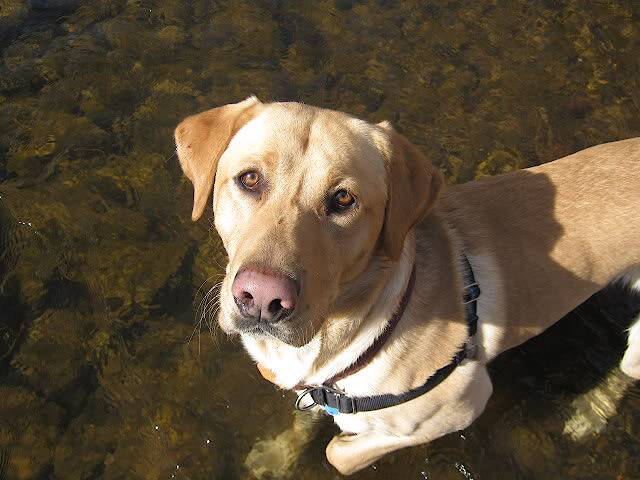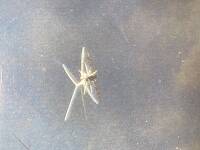
Salmonflies
Pteronarcys californica
The giant Salmonflies of the Western mountains are legendary for their proclivity to elicit consistent dry-fly action and ferocious strikes.
Featured on the forum

This is an interesting one. Following the keys in Merritt R.W., Cummins, K.W., and Berg, M.B. (2019) and Jacobus et al. (2014), it keys clearly to Ephemerella. Jacobus et al provide a key to species, but some of the characteristics are tricky to interpret without illustrations. If I didn't make any mistakes, this one keys to Ephemerella mucronata, which has not previously been reported any closer to here than Montana and Alberta. The main character seems to fit well: "Abdominal terga with prominent, paired, subparallel, spiculate ridges." Several illustrations or descriptions of this holarctic species from the US and Europe seem to match, including the body length, tarsal claws and denticles, labial palp, and gill shapes. These sources include including Richard Allen's original description of this species in North America under the now-defunct name E. moffatae in Allen RK (1977) and the figures in this description of the species in Italy.

Troutnut is a project started in 2003 by salmonid ecologist Jason "Troutnut" Neuswanger to help anglers and
fly tyers unabashedly embrace the entomological side of the sport. Learn more about Troutnut or
support the project for an enhanced experience here.
Lastchance on May 7, 2010May 7th, 2010, 2:22 am EDT
Just curious. What do you use for sulphur spinner wings? I've been using light dun poly.
Bruce
Bruce
Martinlf on May 7, 2010May 7th, 2010, 2:27 am EDT
I like hackle spinners. I use oversize hackle and tie either a parachute or a wrapped hackle wing and cut it off on the bottom (and sometimes on the top). I also use snowshoe and CDC on smaller spinners. I've seen Webwing spinners that work very well also, but I haven't tried them myself. Yet.
"He spread them a yard and a half. 'And every one that got away is this big.'"
--Fred Chappell
--Fred Chappell
Oldredbarn on May 7, 2010May 7th, 2010, 4:38 am EDT
Honey Dun rooster hackle.
I have been tying some flies from S. Nemes "Spinners" book. They look wonderful and he uses either rooster or hen...I haven't tried them yet...Will give a report in a few weeks. They look very realistic to me and therefore may be difficult to see with my 56 year old eyes, but I'll let you know. They float flush in the film.
The interesting thing Nemes did in this book was to mic the abdomens on different spinners and he concludes we are tying fat bugs for the most part. He found some that are not that much thicker than the hook shank...He ties them with just tying thread and fine gold wire.
Parachute style flies work well to imitate a spinners profile or silhouette and are easy to follow on the water.
I'm rather fond of a spinner I tie based on a fly by Datus Proper. In his, "What the Trout Said", he uses a literary device where he claims to have conversations with trout in different places where he's fished. After the results I've had when fishing his ideas I'm not too sure it was just a device. Some guy named Vincent Marinaro was rather fond of Mr. Proper as well.
Spence
I have been tying some flies from S. Nemes "Spinners" book. They look wonderful and he uses either rooster or hen...I haven't tried them yet...Will give a report in a few weeks. They look very realistic to me and therefore may be difficult to see with my 56 year old eyes, but I'll let you know. They float flush in the film.
The interesting thing Nemes did in this book was to mic the abdomens on different spinners and he concludes we are tying fat bugs for the most part. He found some that are not that much thicker than the hook shank...He ties them with just tying thread and fine gold wire.
Parachute style flies work well to imitate a spinners profile or silhouette and are easy to follow on the water.
I'm rather fond of a spinner I tie based on a fly by Datus Proper. In his, "What the Trout Said", he uses a literary device where he claims to have conversations with trout in different places where he's fished. After the results I've had when fishing his ideas I'm not too sure it was just a device. Some guy named Vincent Marinaro was rather fond of Mr. Proper as well.
Spence
"Even when my best efforts fail it's a satisfying challenge, and that, after all, is the essence of fly fishing." -Chauncy Lively
"Envy not the man who lives beside the river, but the man the river flows through." Joseph T Heywood
"Envy not the man who lives beside the river, but the man the river flows through." Joseph T Heywood
Wbranch on May 13, 2010May 13th, 2010, 1:36 am EDT
Louis wrote;
"I like hackle spinners."
Hackle wing spinners, where you figure 8 the fur thorax around and under the hackle are beautiful. I used to think they had an edge over poly, or other synthetic, wing material. They are much harder (for me) to tie than synthetic wing spinners and take longer to tie. Some of the rivers I fish out west have phenomenal spinner falls and I've been able to compare hackle wing effectivity with synthetic wing. I seldom see any difference in fish catching ability for the average trout that is feeding heavily, especially if other trout are competing. However I have seen situations where there may be a single lunker, feeding tight up against the bank, where the delicacy of the hackle wing spinner seems to have an edge. So while most of my spinners are tied with synthetic wing material I still tie a few, of certain pattern, with stiff hackle.
"I like hackle spinners."
Hackle wing spinners, where you figure 8 the fur thorax around and under the hackle are beautiful. I used to think they had an edge over poly, or other synthetic, wing material. They are much harder (for me) to tie than synthetic wing spinners and take longer to tie. Some of the rivers I fish out west have phenomenal spinner falls and I've been able to compare hackle wing effectivity with synthetic wing. I seldom see any difference in fish catching ability for the average trout that is feeding heavily, especially if other trout are competing. However I have seen situations where there may be a single lunker, feeding tight up against the bank, where the delicacy of the hackle wing spinner seems to have an edge. So while most of my spinners are tied with synthetic wing material I still tie a few, of certain pattern, with stiff hackle.
Catskill fly fisher for fifty-five years.
Lastchance on May 13, 2010May 13th, 2010, 3:42 am EDT
TNEAL: You're speaking of spent wing spinners, right? Do you have pictures of the method you use to tie in the wings? It sounds better than how I do it. Also, as far as fat bodies, I think Nemes is correct. It's probably best to tie thread bodies or biot bodies.
TNEAL on May 13, 2010May 13th, 2010, 4:49 am EDT
Lastchance:
Yes, spent wing spinners. Interesting you mentioned that... often overlooked is the fact that lots of spinners hit the water before dying and have their wings in various positions..... Sorry, no photos... put the wings on top of each other with wing tips exactly even... make first thread wrap where you want the wings to extend outward from... several more wraps to the rear will secure them... take thread back to original position.... pull one wing toward you and take one or two wraps to hold it in place; repeat with the other wing... quick and accurate spent wings... the best method by far that I've found... started doing it 28 years ago after having been shown this method by Clarence Roberts, our old conservation officer and well-known area tyer.. he originated one pattern in particular that is among the best parachutes patterns ever
Yes, spent wing spinners. Interesting you mentioned that... often overlooked is the fact that lots of spinners hit the water before dying and have their wings in various positions..... Sorry, no photos... put the wings on top of each other with wing tips exactly even... make first thread wrap where you want the wings to extend outward from... several more wraps to the rear will secure them... take thread back to original position.... pull one wing toward you and take one or two wraps to hold it in place; repeat with the other wing... quick and accurate spent wings... the best method by far that I've found... started doing it 28 years ago after having been shown this method by Clarence Roberts, our old conservation officer and well-known area tyer.. he originated one pattern in particular that is among the best parachutes patterns ever
Pm10flyrod on May 15, 2011May 15th, 2011, 9:23 am EDT
Many of my spinners are tied with hackle, para-style around a 6x mono loop, then the loop pulled down over eye and tied off. Then wet and stoke the fibers to gather. Wind back....tie in tail, dub, whip finish. They are as indestructable as poly wings, and more transleucent.
Paul
Paul
Success lies just beyond where the average man quits!
JOHNW on May 15, 2011May 15th, 2011, 10:45 am EDT
My problem with fishing any spent wing spinner is seeing the thing on the water. I'm OK with tricos due to the time of day the fall happens. Throw low light into teh mix and it becomes a real challenge. For this reason I tend to favor a parachute with a short post and wedge trimmed out of the hackle both fore and aft to give the impression of the spent wing silhouette.
Another option is to drop a soft hackle off the bend of a more visible dry fly. If you slightly grease the wet fly it will stay in the film and you have a ready made indicator in the dry.
Pm10,
The hackle stacker style you speak of is also a good one.
JW
Another option is to drop a soft hackle off the bend of a more visible dry fly. If you slightly grease the wet fly it will stay in the film and you have a ready made indicator in the dry.
Pm10,
The hackle stacker style you speak of is also a good one.
JW
"old habits are hard to kill once you have gray in your beard" -Old Red Barn
WestCO on Jul 29, 2011July 29th, 2011, 10:09 am EDT
During a good spinner fall you don't need to see the fly as much as you need to know the general location. I fish mine blind under the surface, and will occasionally throw on a big Green Drake just for an index. In many cases the Green Drakes and PMD's coincide so sometimes they draw strikes as well. But with a good spinner fall the water is boiling so I say if you see a rise in the general direction, its either you, or its worth the effort because you're probably landing a fish in the next case anyways.
I tie mine with poly yarn and I think the most important features are the profile and color so I really focus on getting that tail spent, the wings flat, and the color nice and rusty.
I tie mine with poly yarn and I think the most important features are the profile and color so I really focus on getting that tail spent, the wings flat, and the color nice and rusty.
...but fishermen I have noticed, they don't care if I'm rich or poor, wearing robes or waders, all they care about is the fish, the river, and the game we play. For fishermen, the only virtues are patience, tolerance, and humility. I like this.
Troutnut on Jul 29, 2011July 29th, 2011, 12:03 pm EDT
I usually go to a Galloup's Cripple with hackle wings & one white hi-vis wing, with a red quill or brown biot body. Natural fallen spinners are rarely splayed out in the idealistic spread-eagle position, and I find that this cripple pattern represents the real fallen spinners (bodies twisted in various ways, often just one wing flat on the water, etc) very well. I use this pattern a lot, including for duns or as a general attractor. It's probably my favorite hard-to-see dry fly because it works so well on otherwise finicky trout. (My favorite dry flies are big, bright, bushy things that float like a cork and are easy to see, but I only fish them when they work, which they do less often than a Galloup's Cripple.)
When I do want to fish a spread-eagle spinner instead, I get really fancy and tie three lumps of hi-vis across the thorax, then trim them to a perfect mayfly wing shape with special wing burners I cut myself. They take a long time to tie and can be annoying with the line twist, but they look so cool!
When I do want to fish a spread-eagle spinner instead, I get really fancy and tie three lumps of hi-vis across the thorax, then trim them to a perfect mayfly wing shape with special wing burners I cut myself. They take a long time to tie and can be annoying with the line twist, but they look so cool!
Jason Neuswanger, Ph.D.
Troutnut and salmonid ecologist
Troutnut and salmonid ecologist
Sayfu
Posts: 560
Posts: 560
Sayfu on Aug 28, 2011August 28th, 2011, 9:58 am EDT
Best winging I've used in a long time, for small flies like PMD's, BWO's for dun wings, or spinner wings are EP fiber sold in a long skein. Just cut off the length needed, can be trimmed after, takes floatant. I use grey fibers.
But this year we had an exceptional Grey Drake fall because of our very high water (Grey Drake fall on the Henry's Fork of the Snake) and a parachute Adams in a size #12-14 worked exceptional at matching the spinners.
But this year we had an exceptional Grey Drake fall because of our very high water (Grey Drake fall on the Henry's Fork of the Snake) and a parachute Adams in a size #12-14 worked exceptional at matching the spinners.
Quick Reply
Related Discussions
Topic
Replies
Last Reply
Re: Three Trouble Makers at the Midwest Fly Fishing Expo the past weekend
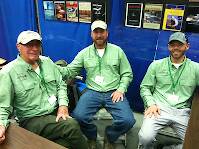
In the Photography Board by Oldredbarn

In the Photography Board by Oldredbarn
3
Mar 11, 2014
by TNEAL
by TNEAL
6
Sep 11, 2020
by Martinlf
by Martinlf
Re: Big Green River, Wisconsin, late September
In the Mayfly Species Baetis brunneicolor by Admiralb
In the Mayfly Species Baetis brunneicolor by Admiralb
1
Sep 30, 2013
by Entoman
by Entoman

